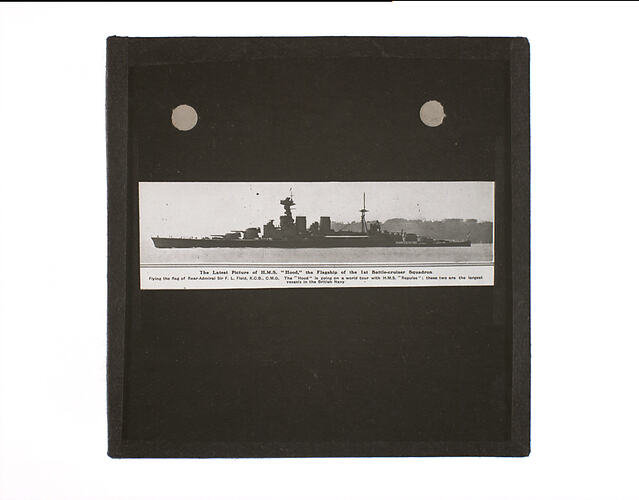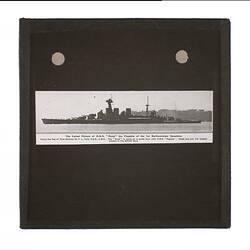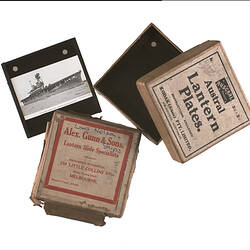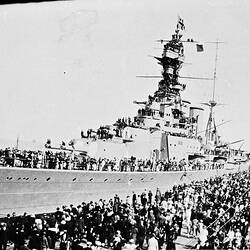Summary
Part of a collection of magic lantern slides relating to British naval history originating from the St John's Home for Boys. These slides were produced in Melbourne after the First World War with images from books and other sources. They are believed to have been used to illustrate lectures to the children in St John's Homes. Several of the slides are marked with the name 'Boreham'. This may indicate a link to Reverend Frank William Boreham (1871-1959), a noted Baptist writer and preacher who used lantern slides to illustrate talks in Melbourne and Tasmania however St John's was an Anglican institution.
Established as St John's Home for Boys in 1923, the home was located in Balwyn Road, Canterbury at 'Shrublands', a mansion formerly the property of investor & businessman John Hindson (1839-1919). His widow Alice Hindson (nee Henty) donated 'Shrublands' to the Anglican Church as a memorial to her husband and William, her late son, to be used as a home for "needy and destitute' boys on the condition it was named 'St John's'. It was officially opened on 22 November 1924 after extensive renovations to accomodate 30-40 boys, also paid for by Alice Hindson. There was a physical link with British naval history as Dame Nellie Melba donated a chapel lantern to St John's Home supposed to be one of those used by Admiral Lord Nelson in the cabin of his flagship HMS Victory. She also donated a cabin bell and wooden spars from HMS Victory. The latter were turned into candle holders.
Named after the 18th-century Admiral Samuel Hood, HMS Hood was the last battlecruiser built for the Royal Navy. Originally one of four Admiral-class battlecruisers ordered in mid-1916, she was the only one completed being commissioned in 1920 after extensive modifications bought about by a review of the Battle of Jutland, which showed up serious limitations in the original design. On launching she was the largest and most powereful warship in the British Navy and remained the pride of the fleet for a generation. HMS Hood was hit by enermy fire and sunk on 24 May 1941, with the loss of all but three of her crew, during the Battle of the Denmark Strait in which the British Navy attempted to block the escape of the German battleship Bismarck and heavy cruiser Prinz Eugen from the North Sea into the Atlantic Ocean.
HMS Hood visited Melbourne from Monday 17th March to Tuesday 25th March 1924, as flagship of the Special Service Battlecruiser Squadron, during an "Empire Cruise" around the world.
Description of Content
Side view of the Royal Navy battlecruiser (42,100 tons) HMS Hood. Following the Battle of Jutland in 1916, considerable extra armour was added to new capital ships under construction including Hood which was launched at the John Brown & Co. yard at Glasgow in August 1918. The four Brown-Curtis shaft-geared turbines used Michell thrust bearings, the invention of Melbourne engineer A.G.M. Michell. Following completion in 1920, Hood was the largest warship of the Royal Navy and completed a world cruise in 1924 with the Special Service Squadron during which she visited Australia including a stop at Melbourne in March 1924. During the World War II Hood served with the Home Fleet and took part in the hunt for the German battleship Bismarck in May 1941. On 25 May 1941 Hood was hit by shells from Bismarck and her escort the heavy cruiser Prinz Eugen and blew up leaving just three survivors of her 1418 crew. A number of Australians serving on Hood at this time were lost including RAN Ordinary Seaman Ian Startup of Williamstown in Melbourne, John Shannon, George Hall and David Hall.
Physical Description
Standard format black and white Lantern Slide with black binding tape.
More Information
-
Collection Names
St John's Homes for Boys & Girls Collection, A.G.M. Michell Engineering Collection
-
Collecting Areas
-
Acquisition Information
Donation from Miss Appleby - St John's Homes for Boys & Girls, 16 Aug 1988
-
Manufacturer (Probable)
Alexander Gunn & Sons, Melbourne, Victoria, Australia, circa 1924
-
Place & Date Used
St John's Homes for Boys and Girls, Canterbury, Victoria, Australia, 1924-1940
-
Format
Lantern Slide, Standard (3¼ in. x 3¼ in.), Black & White
-
Language
English
-
Classification
-
Category
-
Discipline
-
Type of item
-
Overall Dimensions
83 mm (Width), 82 mm (Height)
-
References
'GUIDE TO H.M.S. HOOD', The Argus (Melbourne, Vic), 15 Mar 1924, p.9, [Link 1]
-
Keywords
Australian Military Forces, Children's Homes, Community Organisations & Services, Lantern Slides, Naval Vessels, Orphanages, Wars & Conflicts, Warships, World War II, 1939-1945



